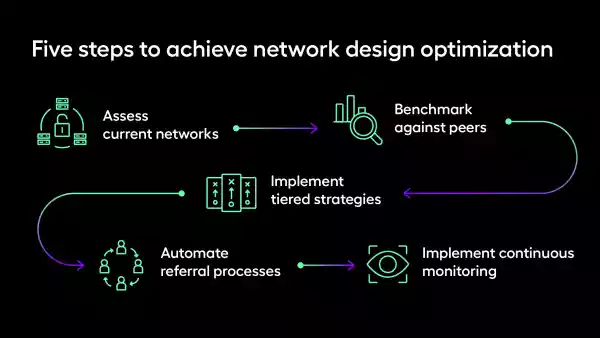Design high-performing healthcare networks with data
At a glance: Network optimization is the process of recruiting and refining the right mix of providers within your network, from primary care physicians to specialists. It also means building the right coverage across all the geographic areas where your organization operates. It’s complicated, difficult work, but it’s the key to success in value-based care. Here, learn how to take the stress out of network design and create healthcare networks that foster growth and drive VBC performance.
What is network optimization?
Network design and optimization is becoming an increasingly important concern as more US healthcare organizations embrace value-based care. The more risk these groups take on in risk-based contracts, the more important it is that they can provide the necessary coverage in-network, no matter the condition or region.
It’s clear that organizations can ensure comprehensive coverage, elevate care quality, and achieve financial sustainability by strategically aligning provider networks, but there are many challenges to optimizing this process. Read on to learn how you can identify and overcome these hurdles to maximize resources and excel under VBC contracts.
The four key challenges of network design
Healthcare organizations often encounter obstacles in their attempts to design and optimize networks. There are many simultaneous challenges, like changing demographics and social determinants of health (SDoH), geographical concerns, and managing provider performance. Here are four major hurdles that an organization hoping to design a high-performing network could face:
1. Inconsistent coverage: Identifying regions with provider shortages can be challenging, leading to gaps in patient access. For example, this could be a matter of employing enough primary care physicians to ensure seamless scheduling, or it could be about making sure patients in a rural area can reach a radiologist in a short drive.
2. Performance variability: Differences in provider quality make it difficult to direct patients to the most effective care, and finding a consistent way to track and measure provider performance is equally challenging.
3. Data limitations: A lack of comprehensive data hampers insights into provider performance, especially in new markets.
4. Financial inefficiencies: Suboptimal network design can increase costs and misallocations. Poor performers waste time and money. Repeated out-of-network referrals get expensive and drain resources unnecessarily.
Optimize your networks with the power of data
Continuously collecting and assessing data is the key to designing a powerful network. An analytics platform streamlines this process. Funneling multiple data sources into one centralized platform ensures that organizations can make informed decisions and build a high-performing network. It lets them see network performance from a bird’s eye view, so decision-makers can expand healthcare networks with a clearer sense of what to expect. With a data analytics tool, organizations looking to expand their networks gain:
- Market intelligence: Using extensive datasets, such as Medicare, Medicaid, and commercial claims, helps healthcare organizations analyze provider density and identify service gaps. This intelligence ensures that organizations design networks to meet patient needs and regulatory requirements, reducing inefficiencies and improving access to care.
- Competitive benchmarking: Understanding how an organization’s network performs relative to its peers allows for targeted improvements. By assessing network performance, organizations can uncover weaknesses, set achievable benchmarks, and refine their strategies to remain competitive in an evolving healthcare landscape by assessing network performance.
- Tiered network management: Structuring provider networks into multi-tiered systems enhances cost control and care quality. Organizations can optimize referrals and improve patient outcomes while managing expenses effectively by categorizing providers based on performance metrics and contractual terms.
- Automated referrals: Integrating referral systems within electronic health records (EHRs) enables seamless patient navigation toward high-performing providers. This reduces bottlenecks, enhances coordination, and ensures patients receive timely, appropriate care, leading to better clinical and financial outcomes.
Five steps to achieve network design optimization
Healthcare organizations aiming to design efficient networks can consider the following steps:
- Assess current networks: Use data analytics to evaluate existing provider distributions and identify gaps.
- Benchmark against peers: Compare performance metrics with similar organizations to set improvement targets.
- Implement tiered strategies: Develop structured networks that balance cost management with care quality.
- Automate referral processes: Leverage real-time data to guide patients to suitable providers efficiently.
- Implement continuous monitoring: Regularly review network performance using analytics to ensure alignment with organizational goals.

Next stop: contract optimization
Optimized networks lead to optimized VBC contracts. You have to build the right team of high-performing healthcare professionals to take on risk and accommodate different populations. By ensuring comprehensive coverage, improving care coordination, and directing patients to high-quality providers, healthcare organizations can better manage costs and outcomes. This alignment with value-based care principles leads to higher reimbursements, better patient satisfaction, and overall financial stability.
On top of an optimized network, contract intelligence tools can reduce manual processes and expedite contract finalization. It also lets decision-makers plug in potential scenarios to anticipate different financial outcomes. These tools help track key performance indicators to ensure contracts meet financial and quality objectives.
From high-powered networks to frictionless performance
Designing and growing a successful healthcare network isn’t just about having the right providers — it’s about creating a smart, data-driven system that helps organizations succeed in value-based care. By solving challenges like gaps in coverage, differences in provider performance, limited data, and high costs, organizations can build stronger networks that deliver better care at a lower cost. Using data tools to track performance, compare against competitors, and improve referrals makes it easier to manage networks effectively.
With the right approach, healthcare organizations can take on value-based care performance with confidence, improve patient outcomes, and excel in tight healthcare markets.
